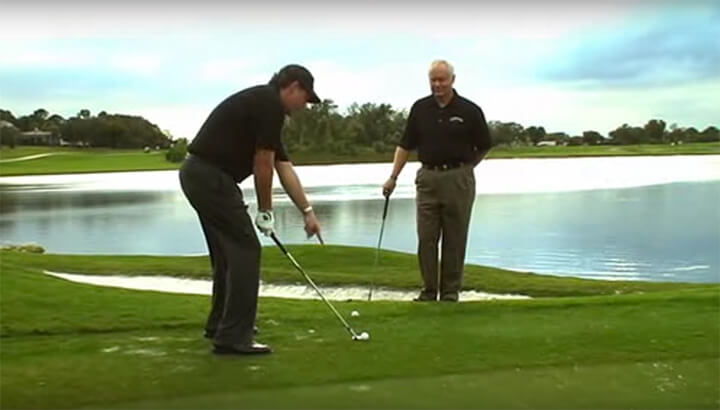Phil Mickelson’s YouTube clip on how to execute the flop shot has had close to 1.4 million views since being uploaded in 2009. To be honest, it’s surprising that this is not closer to 10 or 15 million. After all, he is one of the very best in the business. Each and every player, pros included, could learn a thing or two about this most revered of golf shots from the master of the short game.
The flop is a difficult shot to execute. It requires significant practice, preferably under “real” course conditions. There is little point in rehearsing the flop shot without the pressure of needing to get over a bunker or stop the ball dead before it slips into water, for example!
It is functional but also a “wow” shot. While used rarely, it can get balls out of impossible situations and rescue a result on a hole. But be warned, this is the sort of shot that would benefit from a lesson or two. Add in a bucket of balls on a Sunday afternoon, once a month, under different pressure conditions. Repetition will build confidence.
What is a flop shot?
The flop or lob is a shot that pops up in the air, hangs out for a few seconds and lands dead. There is minimal opening up or run from the shot — unless it’s heading downhill. It’s simply up and down and little else. Sounds easy, huh? Dustin Johnston in a recent Golf Digest article called it the “in case of emergency, break glass” shot. And that is as good a description as you might find — words spoken from one of the world’s best.
A really good look at the design of the club that’s used to execute this shot will give some insight into the dynamics required. The open face produces a big “bottom” or sole that bounces through and off the ground, under the ball, popping it up from the grass. It is sensible to make a strong mental image of the face and sole. When it comes time to visualize the shot, you can “see” the bottom of the wedge moving under the ball and following through.
What club do I use to make a flop shot?
The execution of this shot is best made with your highest-lofted club. For most this would be a 60-degree lob wedge. Others who take the game a little more seriously might even have a 62-degree or greater wedge in their bag. Notwithstanding the club’s loft, there may be a need to create even more for the specific shot by opening up the face. Logic follows that the less face that is created, the more sole and hence increased likelihood of going right under the ball.
When do I do it?
After taking some confidence pills and telling yourself over and over that you really do know how to play this game, the next step is to assess the lie of the ball. How often do embedded balls in the grass really get a close examination? Which way is the grass growing? Is it thick grass or thin? Is there a clump of roots or drier material around the ball at the base of the blades of grass? Can your club move easily through this grass or is the club held up and back? If that all sounds far too serious, perhaps the flop shot is best replaced by something else.
The pros would look for a nearby, identical piece of grass and take several practice swings to get a feel for the resistance and movement of the grass at impact. This also gives them a visualization of the shot ahead.
Generally speaking, the lob or flop is the go-to shot when all other options have been exhausted as viable possibilities. A typical scenario is as follows: Just off the green in fluffy two-inch grass, the pin is eight feet away. But, there is a bunker located directly opposite. A chip will be impossible to stop and it will likely end up in the bunker. You can’t putt it out, even with your driver or rescue. It requires a shot that lifts it right out — a club that will come under the ball and provide just enough momentum to pop it up, move it forward a little and have it fall dead. Or, at worst, it will leak a little distance and run out of steam.
Step-by-step instructions for a flop shot
- Club on the ground — open stance, open face.
- Shift weight forward.
- Stay steady in the shot. Because the clubface area is reduced by loft, the margin for error is increased.
- Don’t give up on the shot — this is where confidence kicks in. “Be the club” doesn’t just apply to whacking your 5-iron into the breeze. “Be the club” also refers to allowing the lob wedge to do its job. It’s only done when a full swing is made and a committed shot is made.
- Accelerate through, like a bunker shot. Don’t assume that deceleration is the key to a softer shot — it’s not. The club will take care of this part of the event.
- Keep your hand in front of the ball as you swing through it.
- Watch the wrists. Try to avoid flipping or flicking wrists to scoop the ball out — let the club do its job!
- Use your weight to determine how far the ball needs to go. More weight forward means more distance.
Short game expertise means having a repertoire of shots. The flop shot must be one of many that can be relied upon to deal with the situation at hand. If confidence flags on this one shot, make sure there is some sort of choice for what to do next.
— N. Incoll
